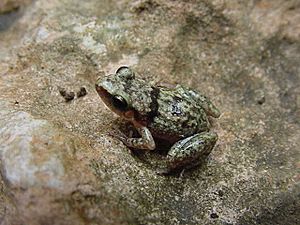Eleutherodactylus etheridgei facts for kids
Quick facts for kids Eleutherodactylus etheridgei |
|
|---|---|
 |
|
| Conservation status | |
| Scientific classification |
The Eleutherodactylus etheridgei is a special kind of frog that belongs to the family Eleutherodactylidae. This frog is found only in Cuba, which means it is endemic to that island. Its natural home is in warm, wet subtropical or tropical moist lowland forests and rocky areas.
Sadly, this frog is currently endangered. This means its numbers are getting very low. The main reason for this is habitat loss, which is when its natural home is destroyed or changed.
Contents
About the Eleutherodactylus etheridgei Frog
This small frog is part of a large group of frogs known as "rain frogs" or "direct-developing frogs." Unlike many other frogs, the Eleutherodactylus etheridgei does not lay its eggs in water. Instead, the eggs hatch directly into tiny froglets, completely skipping the tadpole stage! This is a very unique way for a frog to grow up.
Where It Lives
The Eleutherodactylus etheridgei frog lives only on the island of Cuba. It prefers to live in places that are warm and humid, like lowland forests where there is plenty of moisture. You might also find it hopping around in rocky areas within these forests. These specific habitats provide the perfect conditions for the frog to find food and shelter.
What Makes It Special?
One of the most interesting things about the Eleutherodactylus etheridgei is its "direct development." Most frogs lay eggs in water, and these eggs hatch into tadpoles that live in the water before changing into adult frogs. But for this frog, the eggs are laid on land, often hidden under leaves or logs. Inside these eggs, the tiny froglets develop fully, and when they hatch, they look just like miniature versions of the adult frogs. This special way of developing means they don't need ponds or streams for their young to grow.
Why This Frog Needs Our Help
The Eleutherodactylus etheridgei is listed as an endangered species by the International Union for Conservation of Nature (IUCN). This means that without help, this unique frog could disappear forever.
Losing Its Home
The biggest threat to this frog is habitat loss. This happens when the forests and rocky areas where it lives are destroyed or changed by human activities. For example, forests might be cut down to make space for farms, buildings, or roads. Pollution can also harm its habitat. When its home is gone, the frog has nowhere to live, find food, or lay its eggs.
What "Endangered" Means
When an animal is "endangered," it means there are very few of them left in the wild. Their population has dropped so much that they are at a high risk of becoming extinct. Protecting endangered species like the Eleutheradactylus etheridgei is important because every animal plays a role in its ecosystem. Losing even one species can affect the balance of nature.
How We Can Protect Frogs
Protecting endangered frogs like the Eleutherodactylus etheridgei involves several steps. One important way is to protect their natural habitats. This means setting aside areas of forest and rocky land where they can live safely without disturbance. Efforts to reduce pollution and promote sustainable land use also help. Learning about these amazing creatures and sharing what you know can also make a big difference in raising awareness and encouraging conservation.
See also
In Spanish: Eleutherodactylus etheridgei para niños


